Aarey Milk Colony
| Aarey Milk Colony Aarey Colony | |
|---|---|
| Neighbourhood | |
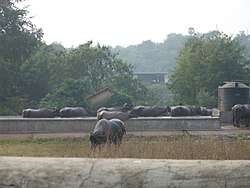 Buffaloes grazing in a dairy farm at Aarey | |
 Aarey Milk Colony Location of Aarey Colony in Mumbai | |
| Coordinates: 19°08′55″N 72°52′54″E / 19.148493°N 72.881756°ECoordinates: 19°08′55″N 72°52′54″E / 19.148493°N 72.881756°E | |
| Country |
|
| State | Maharashtra |
| Region | Konkan |
| Metropolis | Mumbai |
| District | Mumbai Suburban |
| Locality | Goregaon (East) |
| Established | 1949 |
| Founded by | Pandit Jawaharlal Nehru |
| Area | |
| • Total | 16 km2 (6 sq mi) |
| Languages | |
| • Official | Marathi |
| Time zone | UTC+5:30 (IST) |
| PIN | 400 065[1] |
| Website | Aarey Dairy |
The Aarey Milk Colony (also Aarey Colony) is a neighbourhood situated in Goregaon (East), a suburb of the city of Mumbai, India. It was established in 1949 to revolutionize the processing and marketing of dairy products in the city.
Vision
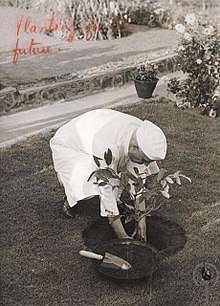
Aarey Milk Colony at Goregaon (East) was established in 1949 and in 1951 the dairy at Aarey was inaugurated by the then Prime Minister, Pandit Jawaharlal Nehru.
The colony was the vision of Mr Dara Khurody, a pioneer of dairy sector who shared the '1963 Ramon Magsaysay Award' with Dr Verghese Kurien for revolutionizing the processing and marketing of milk in Mumbai.[2]
Settlements
.jpg)
Aarey Milk Colony includes 12 villages: Sai, Gundgav, Film City, Royal Palms, Dindoshi (Eksar Pahad), Aarey, Pahadi Goregaon, Vyraval, Kondivita, Maroshi (Marol), Parjapur, and Paspoli. In 1977, around 200 ha (490 acres) of land was carved out from Aarey village to establish Film City.[3] The colony is spread over 16 km2 (6 sq mi) and is located off the Western Express Highway (WEH). Among the popular attractions in Aarey are Chhota Kashmir with a lake and a picnic spot.[4]
Developments
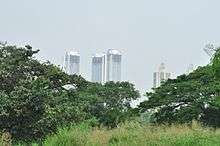
The colony also has gardens, a nursery, lakes, an observation pavilion, picnic facilities, and milk plants. 16,000 cattle are reared on 1,287 ha (3,180 acres) of land, and 32 cattle farms.[5] The management of all these is outsourced to a private firm every two years.[6] Film City is frequently used for movie shoots.
There is a road within the colony built by the Maharashtra Public Works Department that connects the WEH to Powai. The Aarey Colony administration earlier collected toll from the users of the road.[7] In 2014, the MCGM took over the road and ended the collection of the toll.[8] It is also the location of the proposed carshed and depot for Line 3 of the Mumbai Metro.
A plan was mooted in 2010 to extend the existing Byculla Zoo in South Mumbai by building a zoo with no enclosures on land that would be acquired from both the colony as well as the adjacent Sanjay Gandhi National Park.[9]
Ownership pattern
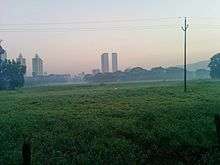
The Aarey Milk Colony occupies a total area of 3,166 acres (1,281 ha) of land, out of which the area available for cultivation of quality fodder and grasses is 400 acres (160 ha) only. Land is also leased out to various organizations and institutions of the Maharashtra State Government and Central Government of India. Allocation of land is as follows:
- Total land given to the Central Government of India Institutions (Central Poultry Farm, Modern Bakery, NDDB, RBI)—229.92
- Total land given to the Maharashtra State Government Institutions (Mumbai Veterinary College, SRP, MHADA, MCGB, Film City, Fishery)—729.12
- Area under road and buildings—460.00
- Area uncultivated and waste land under nullahs, lake, farm bunds, farm roads, river channels—1,020.20
- Area under lawns and gardens, paragrass, and orchards— 537.00
- Land and the social forestry land, etc.—183.00
- Total—3,160.00
The main objective to erect such colony:
- Shifting of cattle/buffalo from the city limits,
- Supply of better quality milk to the citizens of Mumbai at comparatively cheaper cost, and
- Maintenance of these animals on scientific and modern animal husbandry practices.
In the colony, 30 stables are constructed having a capacity for housing 500–550 animals in each stables. Each stable has been provided with an ancillary building such as hay godown, chaff-cutting sheds, calving lines, and residential accommodation for the cattle owner and their staff. The private cattle owner who are maintaining their herds in the Mumbai city prior to 1949 were shifted and allotted licences to maintain their buffalos in the colony stables. Presently, Aarey Milk Colony has got the capacity of accommodating 16,079 cattle in 30 units. The licence holders are required to pay the necessary license fee, occupation charges, water and electricity charges and other ancillary services rendered to them.
In addition to the activities of maintaining the large herds of milch animals in Aarey Colony, certain activities like running primary school for the benefit of children of residents of the Aarey Colony and running 24 bed hospital are also undertaken by Aarey authorities.
- Animal Husbandry Scheme, Cow Unit Scheme
Under this scheme, nearly 1,700 indigenous and cross-breed cows are maintained at four Dairy Farms Units. The indigenous herd is utilized for producing large numbers of cross-breed heifers which are supplied to the farmers of dairy co-operatives in Maharashtra state to augment the milk production and the generation of cross-breed herd will be utilized to study the effect of cross-breeding up to 7.5% and 6.5% exotic blood level. This study will be useful to advise the farmers in the Maharashtra state regarding the breeding policies that can be practiced by them for breeding their cross-bred progeny at the village level. Maintenance of cross-breed herds will be economic while the indigenous herds will be showing some amount of losses, but it will be a good study for future planning.
In order to increase the revenue and decrease the losses incurred, the following activities were initiated from 2001–02.
- The toll tax collection for the vehicles using the Aarey Milk Colony main road from Powai, Malad-Borivali, Dindoshi, Goregaon, Andheri, Marol-Maroshi by calling the public tenders.
- The Aarey tank measuring 3–4 acres is utilized for boating purpose on fixed rent basis.
- The unutilized godowns which were earlier used for storing the fodder and concentrated animal feed are rented to various parties by calling the public tenders.
- Various stall open spoken were allotted for vendors' stalls, restaurants, general stores on rental basis.
- The agricultural produce from the various trees. E.g. Coconuts, mangoes, cashews, and palmyra fruit, etc. were given as contractual basis.
- The various recourses and by-products. E.g. Water, fodder plot, and cattle are being sold on contractual basis.
The various activities are carried out by the staff of around 640 personnel under the administrative control of Chief Executive Officer, Aarey Colony.
Issues
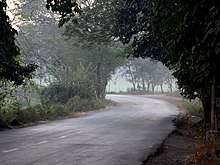
The road that connects the Western Express Highway from Goregaon Check Naka to Marol Check Naka and Powai Check Naka is desolate between 10 p.m. and 7 a.m.[10] The thick vegetation hides wild animals like leopards, who usually prey upon stray dogs and feral pigs.[11][12] In recent years, increased human encroachment into leopard territory and shortage of prey density in the neighbouring SGNP have turned some leopards into man-eaters.[13][14] On 22 December 2016, the headless body of a 22-year-old man, Brandon Gonsalves, was found near Unit 2 of Aarey Colony.[15] The Mumbai Police suspected that it was a case of human sacrifice performed by some tantrik babas.[16] Apart from criminal activities like murders, road robberies, and occult practices, there are apocryphal tales of ghosts trying to hitch rides.[17] The clearing of forest land for the construction of a Metro car shed and Maharashtra Motor Vehicle Department's decision to establish a Regional Transport Office in Aarey are major concerns for environmentalists.[18][19]
In popular culture
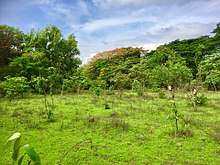
A large portion of Bimal Roy's Madhumati (1958) was shot in the area, to match the earlier footage shot in Nainital.[20]
References
- ↑ "Postal Index Number (Pincode): Aarey Milk Colony, Mumbai". Department of Posts, India. Retrieved 27 August 2017.
- ↑ "Move to expand Aarey dairy production capacity". Business Line. Mumbai: The Hindu Group (published 28 July 2010). 27 July 2010. Retrieved 27 August 2017.
- ↑ Shaikh, Ateeq (6 March 2017). "Aarey car depot may become Parjapur depot". Daily News and Analysis. Mumbai: Diligent Media Corporation. Retrieved 27 August 2017.
- ↑ Nunes, Averil (2 August 2013). "How many of these 20 Picnic Hotspots have you visited?". Daily News and Analysis. Mumbai: Diligent Media Corporation. Retrieved 27 August 2017.
- ↑ "Home page". Save Aarey Organization. Retrieved 27 August 2017.
- ↑ Pathak, Manish K (4 February 2011). "ACB traps officer of Aarey Milk Colony in Mumbai". Daily News and Analysis. Mumbai: Diligent Media Corporation. Retrieved 27 August 2017.
- ↑ Waghmode, Vishwas (23 November 2011). "PWD wakes up to Mumbai Aarey Road's pitfalls". Daily News and Analysis. Mumbai: Diligent Media Corporation. Retrieved 27 August 2017.
- ↑ "Civic body to end toll collection, begin repair work on Aarey Colony road". Mid Day. Mumbai: Jagran Prakashan Limited. Mid-Day Infomedia. 19 August 2014. Retrieved 27 August 2017.
- ↑ Ashar, Sandeep (31 March 2011). "Plan for zoo at Aarey Colony gets a fillip". The Times of India (online ed.). Mumbai: The Times Group. Retrieved 27 August 2017.
- ↑ "Mumbai: Meet the fake policewoman who has terrorised Aarey". Mid Day. Mumbai: Jagran Prakashan Limited. Mid-Day Infomedia. 26 March 2015. Retrieved 27 August 2017.
- ↑ Bhagat, Simit (30 July 2010). "Aarey of problems". The Times of India (online ed.). Mumbai: The Times Group. Retrieved 24 November 2017.
- ↑ Chatterjee, Badri (31 May 2017). "In pics: Rare birds, animals, insects, Mumbai's Aarey Milk Colony is real-life jungle book". Hindustan Times. Mumbai. Retrieved 24 November 2017.
- ↑ Chatterjee, Badri (23 October 2017). "Sudden rise in leopard attacks in Mumbai's Aarey Colony in 2017: What's the reason?". Hindustan Times. Mumbai. Retrieved 24 November 2017.
- ↑ "Photos: Mumbai's Aarey Colony in fear, leopard attacks highest since 2002". Hindustan Times. Mumbai. 26 October 2017. Retrieved 24 November 2017.
- ↑ Navalkar, Priya (31 March 2017). "Aarey cops makes little progress in beheaded body case". The Asian Age. Mumbai. Retrieved 27 August 2017.
- ↑ Pathak, Manish K (20 January 2017). "Aarey murder: Blind spot leads Mumbai police to dead end". Hindustan Times. Mumbai. Retrieved 27 August 2017.
- ↑ Awatramani, Tarini (21 April 2010). "Ghosts galore: Mumbai's most haunted locations". Cable News Network. CNN Travel. Mumbai. Retrieved 27 August 2017.
- ↑ "Mumbaikars hug Aarey trees over Metro car shed". The Times of India (online ed.). Mumbai: The Times Group. 15 October 2017. Retrieved 24 November 2017.
- ↑ Korde, Kailash (22 November 2017). "After Metro, motor vehicle department wants Mumbai's Aarey Colony land for RTO". Hindustan Times. Mumbai. Retrieved 24 November 2017.
- ↑ "It's 50 years since Madhumati captured the hearts and minds of a nation. Sunday MiD DAY recounts the making of a classic". Mid Day. Mumbai: Jagran Prakashan Limited. Mid-Day Infomedia. 19 January 2008. Retrieved 27 August 2017.
External links
| Wikimedia Commons has media related to Aarey Milk Colony. |